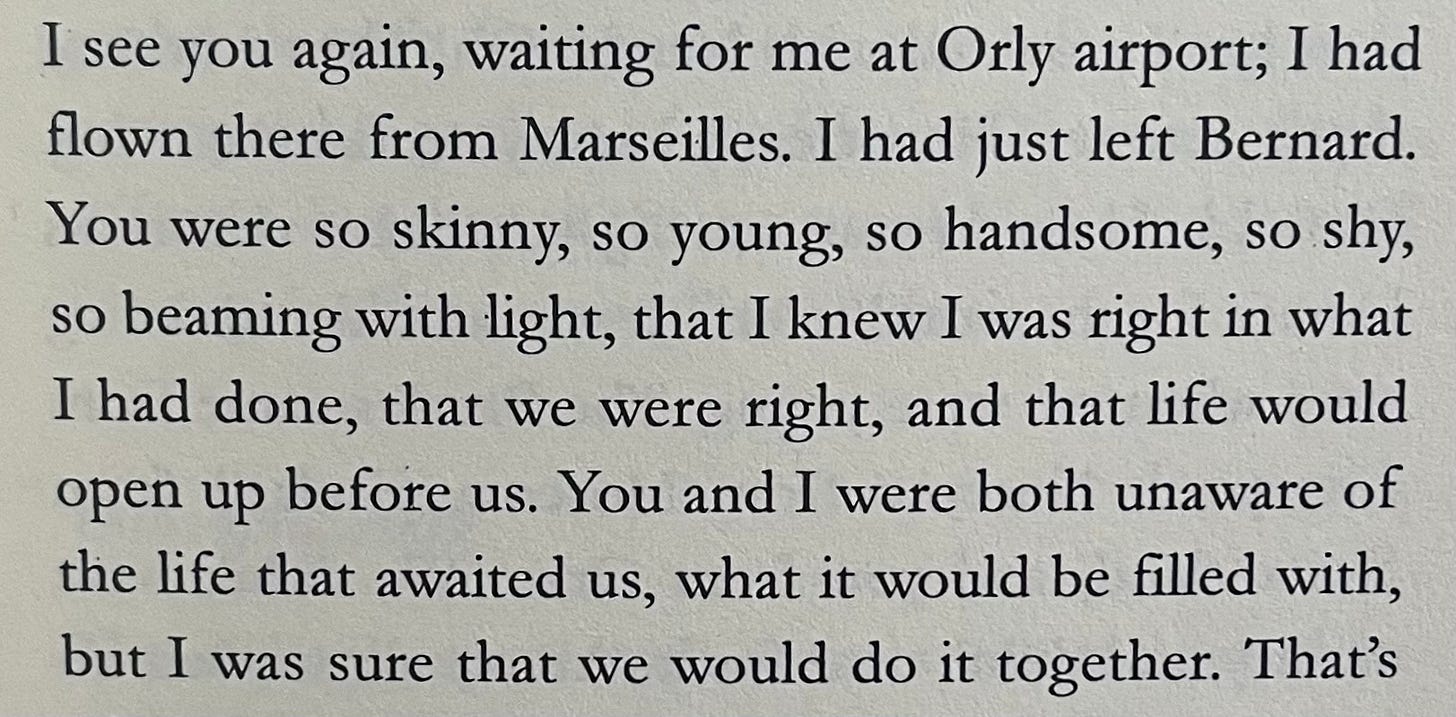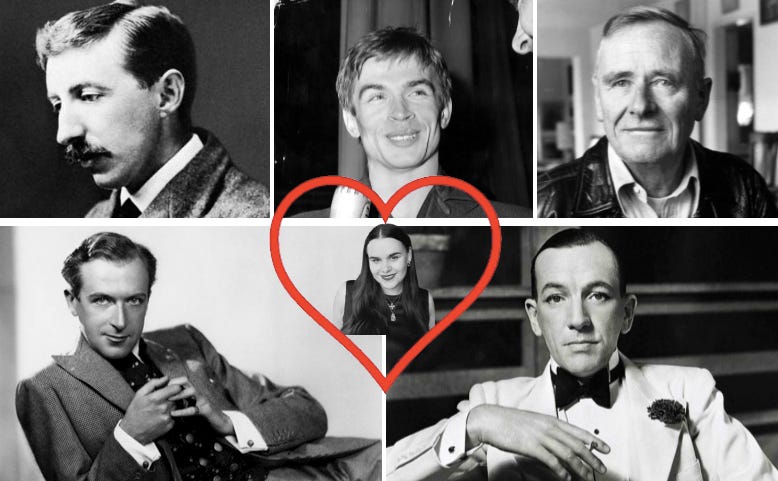Can you give me a quick summary? Can you condense 93,000 words into something you could pitch in an elevator only going up one floor?
I know that these are very reasonable questions that I need to be able to answer, but god, it’s hell to do so.
I love talking about my work, but when those questions are asked, all your time, work and love is suddenly thrown into question. It leaves you nowhere to hide, but so much space for doubt to creep in.
Whenever someone asks me what my book is about, cortisol pumps through my body and I am struck dumb, like a glassy-eyed Julianne Moore in Magnolia waiting for her prescription, “Uhhh, I don’t-”
It’s just, I don’t, well, you might not, gosh, I don’t know where to begin…
It begins with Yves Saint Laurent
My book, Margot, started in the Spring of 2018, in a shaded alcove of the Jardin du Luxembourg overlooking the Grand Bassin. I was sitting on a green metal chair and was reading Letters to Yves. I had just crossed the Seine from my first-ever visit to Musée Yves Saint Laurent, which had been something of a seminal experience.
I was twenty-one and still wanted to be a prodigy, and within the walls of a former atelier, I saw Yves, his genius and flaws laid bare. Perhaps it was arrogance, but in those blue eyes hidden behind long fingers and Maison Bonnet glasses, I saw something of myself. He was reserved and shy, yes, but ferociously determined too. It was very easy to think him worthy of aspiration.
In the gift shop, I bought the book I was now reading, a series of posthumous letters written to Yves by Pierre Bergé, his former lover and business partner, that reinforced Yves’ narrative and mythos; his rapid rise and fall at the house of Dior, a forced conscription, a brutal hazing, a brief stay in a facility and a successful lawsuit, and then -
This brief excerpt of one letter forged a whole arc; uncertainty to certainty, a homecoming and a happy ever after. The first thought I had I was so sure of that I remain certain that I said it aloud:
“This should be done with lesbians.”
And that was it. The idea hung around in my mind, firmly in the ‘save for later’ file. One night in 2019, I ran my friend AJ through every project I wanted to write, and pitched the idea for my book as solely, Lesbians in Paris. They liked the sound of that one best.
Three years passed and a few developments were made in a star-covered notebook. The protagonist was an English journalist named Margaret-Rose, but known as Margot, and the story would be set in Paris in 1961.
It went to Paris and back
The first draft was written in Paris in June 2022, and just six months later (though it felt like an eternity at the time) I was eating Boeuf Bourguignon in Covent Garden sat opposite one of the country’s best-known literary agents, as she picked apart my cover letter word by word.
“You haven’t mentioned a lot of contemporary authors. Is Nancy Mitford necessary?” she asked.
“Well, isn’t Nancy Mitford a kind of shorthand? Like when rich people ask where you went to school1 and where you ski2? When I say Nancy Mitford, you know I mean an upper-class ‘witty’ journalist, except my one’s a lesbian and not related to fascists.”
“Do you like Nancy Mitford?”
“No, I can’t stand her.”
“So why mention her?”
It sounded rather obvious when she said it. The reference to Ms Mitford was dutifully scrapped, with no authors of a similar oeuvre replacing her. Instead, I said that my novel was like the works of Sarah Waters (accurate), Naoise Dolan (perhaps), and Annie Ernaux (an incredibly bold statement!), but even then, there isn’t a clear intersection of these author’s work where I can make easy comparisons.
I wish more literary agents were cine-literate (not you, Emma Paterson) because then I could say that Margot’s old English world is very much like Pablo Larraín’s Spencer and the new Parisian world is the glorious technicolour of Jacques Demy’s Les Demoiselles de Rochefort, with the story containing the verklempt highs and lows of Agnès Varda’s Cléo de 5 à 7, if Cléo was English and dating Dorothée.
It’s a proudly feminist and feminine book, because I am a queer, silly, shallow and deeply chic woman. It’s a fashionable book written by a fashionable lady - do you seriously think I’m going to include the designs of Cristóbal Balenciaga and Marc Bohan and have Karl Lagerfeld make a cameo appearance and I’m then going to put on some Lucy and Yak dungarees? If anything, this is positive representation; we haven’t had a well-dressed lesbian since Dusty Springfield. I can see that Kristen Stewart is trying her best in Chanel, but she still turned up to the Oscars in shorts. Jodie Foster would have gotten a pass for her outfit when she won the Oscar for The Silence of the Lambs, but…Those. Gloves. Were. A. Choice.
It ends happily
“A happy ending was imperative. I shouldn't have bothered to write otherwise. I was determined that in fiction anyway two men should fall in love and remain in it for the ever and ever that fiction allows,” - E.M. Forster on Maurice.
If Margot is meant to be anything, it’s Maurice. It has the imperative happy ending that Maurice and Alec were afforded, that Yves and Pierre would appear to have, had Pierre’s letters stopped in the arrivals hall of Orly airport. It’s a story of leaving a cruel world behind in the hope that a new one may be kinder. It’s a story of defection, it’s Rudolf Nureyev at a press conference at the Théâtre des Champs-Elysées, saying, “I may never return to my country, but I may never be happy in yours.”
(You should watch Ralph Fiennes’ The White Crow, Oleg Ivenko gives a powerhouse performance as Rudolf Nureyev and Ralph wears a fatsuit and speaks poorly-accented Russian. It genuinely changed my life.)
It’s bittersweet and fun. It’s more Isherwood than Forster; a novel in which Cecil Beaton casts a very long shadow. It’s camp, because I am camp. My friend Dominic recently called me the human personification of a cigarette holder and my only response was that I hoped I was Noël Coward’s.
It’s not as if this is new - for my 13th birthday party, I made my friends sit down and watch my then-favourite film, the 2008 adaptation of Easy Virtue, starring Jessica Biel and Kristen Scott Thomas. Do you think it’s been an easy ride having had this personality fixed for the past 14 years?
Don’t get me wrong, my life is a complete joy, but it can be a little isolating being so enamoured with a world and people lost to history. I know that I am not alone and that people like me would want to read this book, and that there are people for whom reading this book would be greatly refreshing; too many books about queer women still veer too closely to the despair found in The Well of Loneliness. Queer women have no Red, White and Royal Blue or Heartstopper (probably for the best), I can at least offer some Ciné-Tamaris joie de vivre about a Nancy Mitford-esque journalist.
Yes, I could have written a story set in the present day, but maybe I felt a responsibility to keep that old world alive, to make as many people love it as I do.
If every I do, as I believe it does, begins and ends with Ralph Fiennes, where else should I look but the denouement of The Grand Budapest Hotel?
I think her world vanished long before she entered it. But, I will say, she certainly sustained the illusion with a marvellous grace.
*
I saw AJ earlier this year. They knew I’d written another novel, and that I was about to start sending it out to agents.
“Lesbians in Paris?” they asked.
Oh, fuck it.
“Lesbians in Paris!”
As per my cover letter:-
Margot is a queer romance novel that sits somewhere between the work of Naoise Dolan, Annie Ernaux and Sarah Waters, with the title and plot intended as both homage and female counterpart to Forster’s Maurice. The story is one of joy and optimism as Margot grows in confidence within a new and accepting world. This change is reflected in her narration, which is light-hearted and witty, with a streak of Noël Coward-esque irreverence.
A list of films that have inspired Margot or are referenced in Margot, can be found here.
Haberdashers’ - not the private school in Elstree, but the state school in Lewisham. However, vast experience has proved that if I just say Haberdashers’ in a Sloaney voice to someone posh they will draw their own conclusions that I’m referring to the fee-paying school and I will not correct them.
Klosters - once on a work trip, which I appreciate does not make it any better, but it was the strangest, most sleep-deprived week of my life, and the altitude gave me three mouth ulcers.










I absolutely loved reading your post! The way you describe your journey, drawing inspiration from Yves Saint Laurent and infusing your story with literary and cinematic influences, is truly captivating. Keep up the fantastic work, and I can't wait to read more about Margot and her adventures in Paris! 😊✨
This was a dream to read. Damn, you write so well! You are totally wasted in admin, I think we can all agree. Your footnotes made me giggle - the best thing about that particular ski trip was becoming friends with you. xx